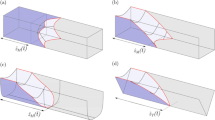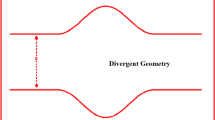Abstract
WHEN a glass tube, 6.5 mm. in external diameter, 5 mm. in internal diameter and of any convenient length, one end of which has been drawn out into the form of a cone 55 mm. long with a hair-like apex 0.1 mm. in diameter and a correspondingly small aperture (Fig. 1 (1)) is filled with water containing, say, 1 per cent. of caustic soda, and held with its point downwards at an angle of 35° above the horizontal, a minute stream of water issues from its aperture, turns round underneath its lip and ascends to a distance of 33 mm. on its outer side in the form of a series of minute, disconnected, elongated globules which appear to encircle it. In flowing upwards these globules gradually lose their identity, and finally coalesce with each other to form a substantial drop at a point where the diameter of the cone is about 2 mm.
This is a preview of subscription content, access via your institution
Access options
Subscribe to this journal
Receive 51 print issues and online access
$199.00 per year
only $3.90 per issue
Buy this article
- Purchase on Springer Link
- Instant access to full article PDF
Prices may be subject to local taxes which are calculated during checkout
Similar content being viewed by others
Author information
Authors and Affiliations
Rights and permissions
About this article
Cite this article
GALLOWAY, W. External Capillary Action. Nature 118, 300–301 (1926). https://doi.org/10.1038/118300b0
Issue Date:
DOI: https://doi.org/10.1038/118300b0
This article is cited by
Comments
By submitting a comment you agree to abide by our Terms and Community Guidelines. If you find something abusive or that does not comply with our terms or guidelines please flag it as inappropriate.



